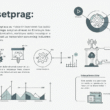In today’s fast-paced digital world, where blockchain technology is gaining widespread adoption, EOSIO has emerged as a leading platform offering scalability, security, and flexibility for decentralized applications (dApps). However, navigating the intricacies of resource allocation within the EOSIO ecosystem can be a daunting task for developers and blockchain enthusiasts alike. In this comprehensive guide, we will delve into the concepts of RAM, CPU, and NET, shedding light on their importance and providing valuable insights to help you optimize your EOSIO resource allocation strategy. If you are curious about Bitcoin, explore how to take Bitcoin payments as a business, as this guide provides valuable information and practical steps to integrate Bitcoin into your payment options.
RAM: Empowering Data Storage and Access
RAM (Random Access Memory) plays a pivotal role in the EOSIO ecosystem by facilitating data storage and access for dApps. In simple terms, RAM stores the state of the blockchain and enables developers to read and write data swiftly. It acts as a temporary storage space, providing quick and efficient access to essential information, such as smart contract code, transaction history, and user data.
The allocation of RAM within EOSIO is critical as it directly impacts the performance and scalability of your dApps. As the demand for RAM increases, its price can surge, making efficient resource management even more crucial. To optimize your RAM utilization, it is advisable to carefully consider the amount of RAM required by your smart contracts, the data storage needs of your application, and potential future scalability.
CPU: Fueling Computational Power
CPU (Central Processing Unit) is responsible for executing transactions and processing smart contracts within the EOSIO network. It provides the computational power required to validate transactions, run complex algorithms, and execute smart contract logic. Similar to RAM, CPU resources are finite and must be allocated judiciously to ensure optimal performance of your dApps.
EOSIO utilizes a resource staking model, where developers can stake their EOS tokens to access CPU resources. The more tokens staked, the greater the CPU bandwidth available for executing transactions. However, in scenarios where the network is congested, CPU resources can become scarce, resulting in delays and increased transaction costs. It is essential to monitor CPU utilization and adjust your resource allocation accordingly to avoid bottlenecks and ensure seamless dApp functionality.
NET: Enabling Network Bandwidth
In the EOSIO ecosystem, NET (Network Bandwidth) determines the rate at which data can be transmitted to and from the blockchain. NET resources are crucial for facilitating communication between dApps, users, and the underlying blockchain infrastructure. They allow for the smooth transfer of data, including transactions, smart contract interactions, and other network-related activities.
Similar to CPU, NET resources are also allocated based on the staking of EOS tokens. By staking a certain amount of tokens, developers can access higher network bandwidth, ensuring efficient data transmission. It is important to monitor your NET utilization and optimize resource allocation to avoid congestion, latency, and potential disruptions to your dApp’s functionality.
Optimizing EOSIO Resource Allocation: Best Practices
To effectively manage your resource allocation within the EOSIO ecosystem, here are some best practices to consider:
- Analyze Application Requirements: Thoroughly assess the RAM, CPU, and NET requirements of your dApp based on factors such as anticipated user base, transaction volume, and data storage needs. This analysis will help you determine the optimal resource allocation strategy.
- Monitor Resource Utilization: Regularly monitor the usage of RAM, CPU, and NET resources to identify bottlenecks and optimize resource allocation. Various monitoring tools and platforms are available that provide real-time insights into your resource utilization.
- Dynamic Resource Allocation: Take advantage of EOSIO’s flexibility in resource allocation by dynamically adjusting your staked tokens based on the evolving needs of your dApp. Be mindful of market conditions, network congestion, and future scalability requirements.
- Efficient Coding Practices: Optimize the efficiency of your smart contracts and dApp code to minimize resource consumption. Clean, well-structured code can significantly reduce RAM, CPU, and NET usage, enhancing the overall performance of your application.
- Community Engagement: Stay connected with the vibrant EOSIO community to gain insights, share experiences, and learn from other developers. Engaging in community discussions and forums can provide valuable tips and strategies for effective resource allocation.
By adopting these best practices, you can streamline your resource allocation strategy, optimize the performance of your EOSIO dApps, and position yourself for success within the blockchain ecosystem.
In conclusion, understanding the concepts of RAM, CPU, and NET is crucial for maximizing the potential of your EOSIO applications. By comprehending the intricacies of resource allocation and implementing effective strategies, you can unlock the true power of EOSIO and propel your dApps to new heights of scalability, performance, and user satisfaction.




